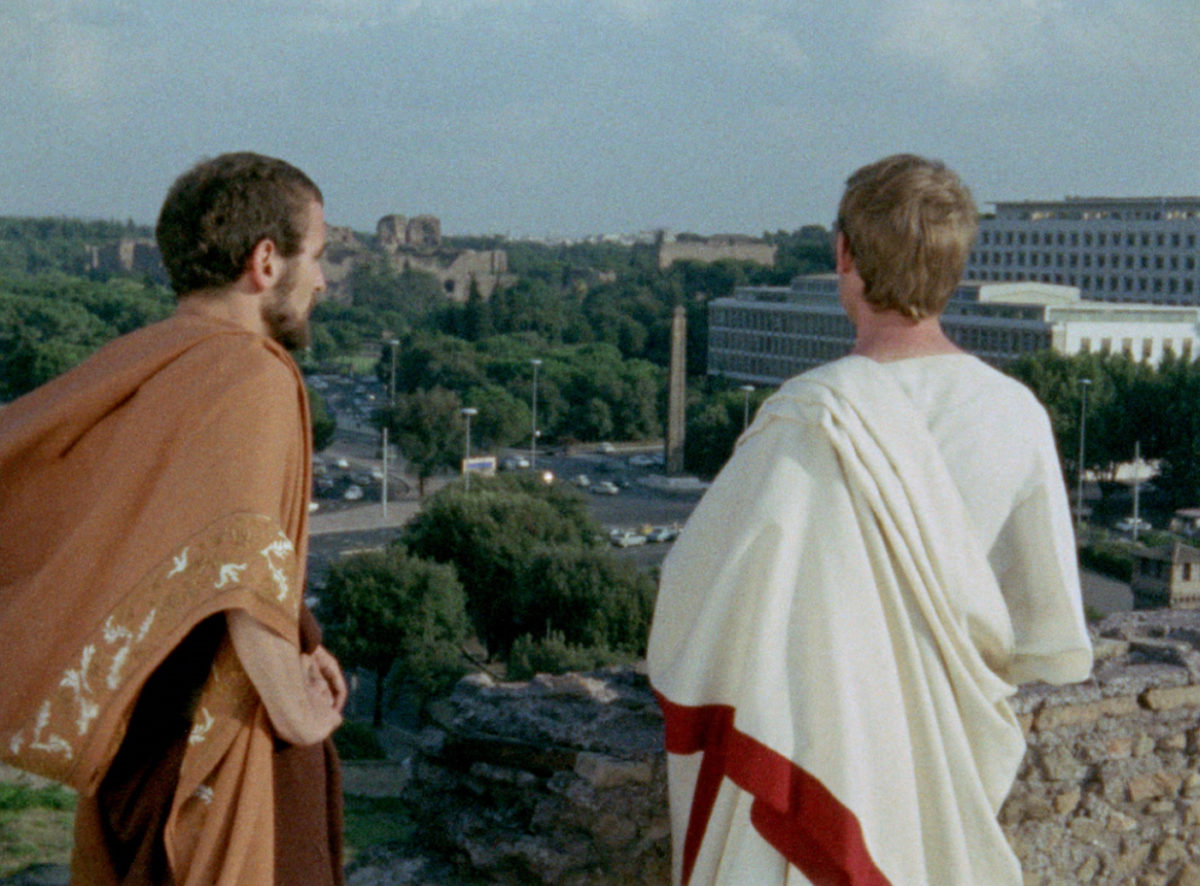“Struggle with the text and the result is the film.” (Straub, 1976)
1. Staging History: Photography and Literary Adaptation
Jean-Marie Straub and Danièle Huillet stumbled into filmmaking after Bresson turned down a project Straub offered him, which would eventually result in the couple’s third film, Chronik der Anna Magdalena Bach (1968). The project entailed finding a similar approach to Bach’s music as Bresson had worked out for Bernanos’ text in his Journal d’un curé de campagne (1951). In an interview in the early 1980s, Straub explicitly connects the aesthetics he developed with his codirector to Bazin’s interpretation of the role of the literary text in Bresson’s adaptation, since the source text figures as “matière esthétique brute”, as ‘raw aesthetic matter’ instead of being adapted (“verfilmt oder umgeschrieben”).This interview is included in the documentary The Beharrlichkeit des Blicks/L’insistance du regard (1993) by Manfred Blank. While Bazin does not use this exact termWhile Bazin never mentions “matière esthétique brute”, he does speak of “fait esthétique brute” in the same essay. This is, in turn, somewhat oddly translated as “cold aesthetic fact” in the english version. Bazin, André, ‘Le Journal d’un curé de campagne and the Stylistics of Robert Bresson’ [1951], in: What is Cinema? Ed. by Hugh Gray. University of California Press, 1967, 140., what Straub aims to describe with it is the use of a literary text left in its “written reality”, of which the literary character is emphasized instead of “adapt[ed] to the situation at hand” (dixit Bazin).Ibid., 136. The text as a material given remains untouched within the film as it is only ever being ‘cut’, i.e. fragmented, and not ‘condensed’, i.e. modified, in order to make it more comprehensible or help it blend into the filmic reality. Over the course of their six earliest films, Straub and Huillet develop an aesthetics in which the literary text, even more than in Bresson’s work, is treated as ‘raw aesthetic matter’ alongside protagonists and locations. This distinguishing characteristic of their cinema will allow the duo to move in on their aim to represent the historicity of the present in a non-didactic manner, in alignment with their search for an emancipatory potential in cinema.
Before tracing this development, it is important to note that their aesthetics can be situated within a particular aesthetic-theoretical framework, namely the Bazinian or ontological tradition, which roots the aesthetics of cinema in the essence of photographic representation. In the aforementioned interview, Straub is at pains to distinguish painting from film as the latter works with photography, and that, he states, “ist eine Gnade”. The religious undertone of their ontological understanding of cinema is indicated through this reference to the grace of photography, that is conceived to redeem a reality otherwise lost.Straub knew this tradition well, as he started his career as a critic in the 1950s, inviting authors such as André Bazin and Henri Agel to his film club based in Metz. Cf. Straub, Jean-Marie. ‘Does Rossellini’s work have a christian meaning?’ [1955], in: Huillet, Danièle and Straub. Jean-Marie. Writings. Ed. by Sally Shafto. Sequence Press, 2016. However, the redemptive quality of film proves insufficient when it comes to Straub and Huillet’s historicization of reality; film’s radical attachment to the present prevents it from accounting for the latter’s historicity. Like a number of other filmmakers addressing the question of history in the 1970s and 1980s (e.g. Godard, Lanzmann, Akerman), Straub and Huillet inquire how past violence constitutes the present. This points to another tradition at work in their aesthetics: a historical materialism epitomized by the work of Brecht, who they have adapted in Geschichtsunterricht (1972), and who is cited in the beginning of Nicht versöhnt (1965), thus being included as a central reference from the very beginning of their oeuvre. The radical aesthetics Straub and Huillet develop tries to formulate a response to this paradox: how can the historical substrate of the present be rendered visible relying on the filmic medium’s nature to capture the here and now?
This demands an analysis of their use of text and how it is related to the visual logic of their films, as language is the seam through which the past may seep into the present. The relation between text and photography, as well as the relation between the temporality of the text and the temporality of the (recorded) present, changes significantly throughout their early oeuvre. This evolution, however, is not a radical revision of their aesthetics, but the fruition of a germ that was present from the start. As the relation between text and image shifts from a representational toward a presentational logic, from descriptivity to literalness, what appears is a further cultivation of their aesthetics in function of a staging of history.
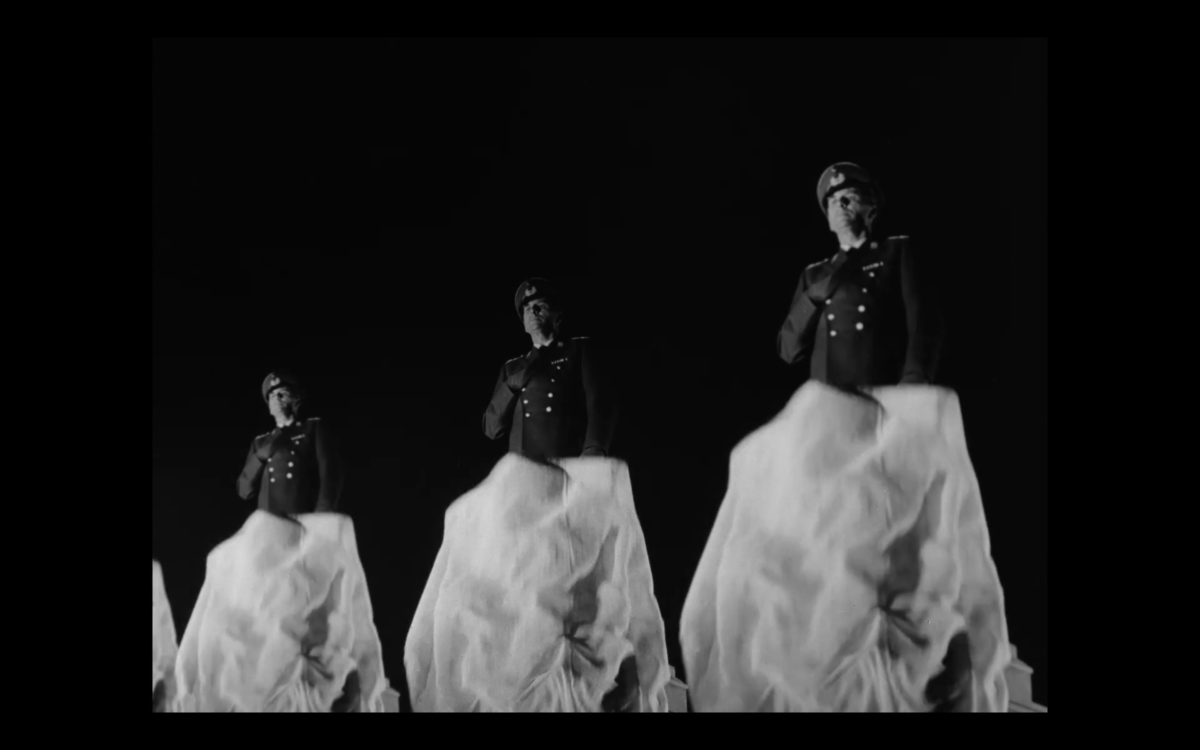
2. Machorka-Muff and Nicht versöhnt: Beyond the Illustrative Image through Fragmentation
Straub and Huillet’s first two films, Machorka-Muff (1963) and Nicht versöhnt (1965), are based on Heinrich Böll’s short story Hauptstädtisches Journal (1957) and novel Billard um halb zehn (1959) respectively. Both films are set in post-war Germany and can in many ways still be considered more or less traditional adaptations. That is, if one looks beyond their extreme formal fragmentation. Everything anecdotal that could clarify or connect the films’ scenes is cut away, as is everything that relates to the characters’ psychology. Although a coherent and fully intelligible narrative is clearly not the aim, the films’ central theme is easily discernible: the endurance of fascism in post-war Germany. The source texts underlying the films guarantee coherence despite their fragmentation: language, the semantic meaning of language, remains the driving power in the film; it connects the scenes no matter how temporally dispersed they are and how arbitrarily they appear to be put together. The temporal structure of Nicht versöhnt is in fact entirely faithful to Böll’s novel, as it plays out, from the perspective of one day, the story of three generations of architects before, during and after the war, as they have built, destroyed and are rebuilding an abbey. The novel cross-cuts through these temporal strata using the same verbal tense, a formal aspect meticulously respected in the film, as none of the flashbacks are introduced or indicated as such. Furthermore, a number of classical narrative devices, soon to be abandoned by the filmmakers, appears in these early works, namely the dream-sequence in Machorka-Muff [pictured above – Ed.] and the use of documentary elements such as newspaper fragments and war footage. Both highlight a heterogeneity in the imagery (dream-real, past-present, fiction-documentary) that hints at Straub and Huillet’s later, far less normative, juxtaposition of heterogeneous filmic realities in a single frame. Generally, their imagery in these early works largely adheres to an illustrative logic that will disappear from their later aesthetics.
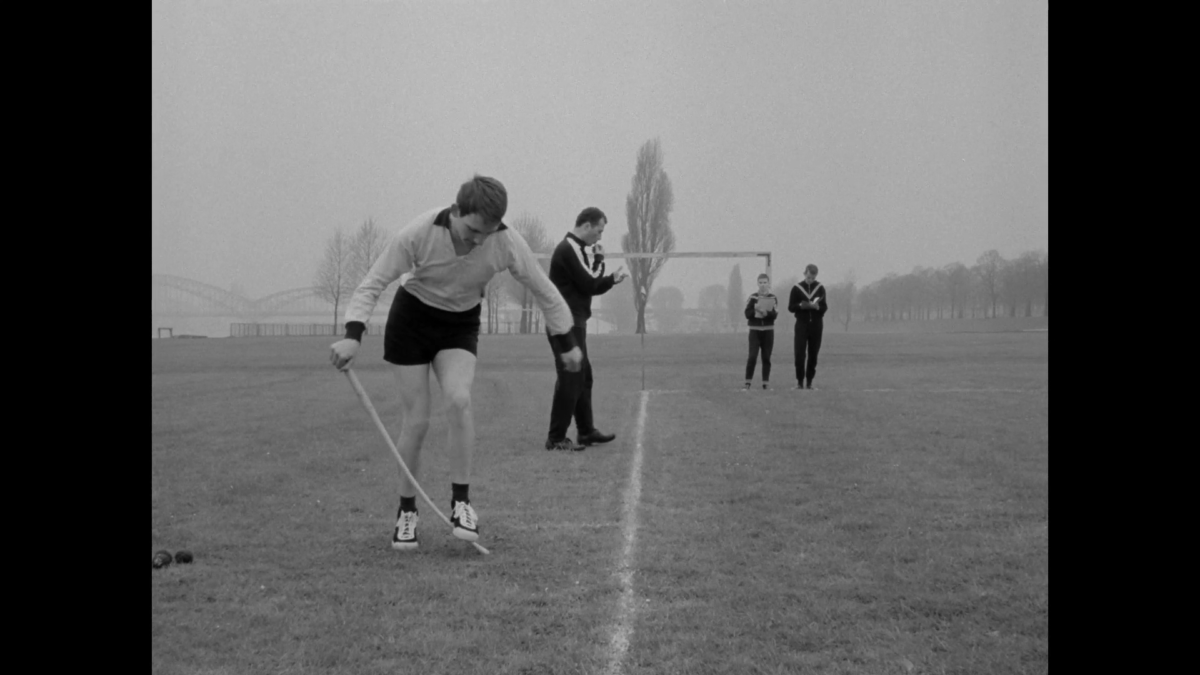
What we can discern in Nicht versöhnt is foremost a descriptive approach in which three consecutive generations of the Fähmel family act as a case study by which a moment in German history (and more particularly bourgeois culture) is anatomized. However, within the imagery’s largely illustrative logic, a number of images display a first hint of the autonomy that would be established through the aesthetic shift towards a more presentational logic, toward literalness. Partially as a consequence of the fragmentary and unchronological structure of the work, some images become metonymic in the sense that the isolated, often rather insignificant events they portray, stand in for the overarching power relations the film criticizes. The summation of these singled out, disconnected moments of bourgeois indifference and ambition-fueled cruelty in turn contributes to the outline of a cultural moment characterized by a latent fascist ideology. The three-shot opening scene illustrates this shift towards the image’s autonomy, even though the first and last shot are accompanied by a voiceover which guides its interpretation. The scene shows a group of schoolboys playing rounders (a team sport resembling baseball), while the man in the voiceover recalls how one of his then-teammates jeopardized their victory in order to hit another boy with the ball. The shot that interposes the two voiceover fragments is not immediately illustrative as to the acts or events discussed, but encapsulates both the aggression and discipline which appear as central to the cultural moment, thereby acting metonymically. Central in a longshot [pictured above – Ed.], we see one of the schoolboys successfully taking a swing at a ball, all the while intensely focusing on an offscreen point in the distance. After the ball’s landed, a look of disappointment crawls over his face as he starts to push down on the bat he’s holding diagonally to the ground with his heel, shattering it. A brief whistle announces the end of the game after which, following the batter, a number of the schoolboys walk into and out of the frame, a military-style uniformity to their pace, the choreographed nature of which stands out the more since the frame remains empty for a number of seconds after the last boy has passed the camera. The misdirected aggression, standing uncorrected as the referee condones the behavior, and the perfect discipline exemplified in the fifth shot, form a micronarrative illuminating aspects of the narrated reality as it unfolds from there on out.
Although text, whether intradiegetically or in voiceover, is often contributive to the narrative quality of the image, the discussed metonymic character recurs throughout the imagery. When a young woman is scolded for referring someone to a man’s office by a patriarchal figure remaining offscreen, we see her obediently turning her face towards the ground in repentance; one of Heinrich Fähmel’s young sons ardently stabs at a statue with a rapier, wearing an oversized helmet formerly used in combat. The result is a puzzle of unhooked instances creating a birds-eye-view on a cultural moment, central to which stand obedience, discipline, authority, ruthless ambition and hierarchies based on who most effectively navigates this web of expectations, rather than merit—as grandmother Fähmel states at one point: “It’s war. Time can be read off in promotions.”
The ending of Nicht versöhnt might exemplify a first stride toward Straub and Huillet’s aim to show the historicity of the present in a single image. ‘Insane’ grandmother Fähmel opts to shoot a postwar democrat, a politician of the future who may still become culpable, instead of the former Nazi-party member who has already caused her family loss and suffering. “The ‘senseless’ shot fired by an insane woman, with which Billard um halb zehn ends,” according to Georg Lukács’, the Hungarian Marxist philosopher, “is one of the few humanly genuine ways of coming to terms with Germany’s Fascist past, precisely because it encompasses what came before and after Hitler as well.”Cited in Byg, Barton. Landscapes of Resistance: the German Films of Danièle Huillet and Jean-Marie Straub. University of California Press, 1995, 100. However, if the ending shows a merging of present, past and future—which Straub and Huillet consider more real than any linear understanding of time—this is only due to their remaining faithful to the novel’s satirical ending. The image’s strength is entirely dependent on the textual template.
The imagery and the film at large are still about the text, as language and image conjointly work towards the single layer of that represented cultural anatomy. Despite the narrative fragmentation, the result remains a coherent, text-driven whole. Due to its operationality within the film, the text cannot manifest itself fully in its materiality, as it primarily functions as the thread that connects the fragments. The imagery in turn remains largely illustrative; what it depicts is incited by the text. Despite the fragmentation and reduction introduced, despite small shifts towards a less classical adaptation—the metonymic image on the one hand and the inclusion of the fairly literal, unadapted text on the other—neither text nor image gain autonomy as both stand in function of one another to serve the narrative.
3. Eyes Do Not Want to Close at All Times: Turning Toward an Aesthetics of Literalness
The aesthetics described becomes far more radical in their later work, inciting a shift in the functionality of its rules. While this development is already notable in Chronik der Anna Magdalena Bach, it culminates in Les yeux ne veulent pas en tout temps se fermer ou Peut-être qu’un jour Rome se permettra de choisir à son tour (1970), which is more widely known as Othon (the title of the ‘adapted’ Corneille play ). Whereas a critique of power relations and authority had to be at first still largely extracted from the text, from the narrative, by Othon Straub and Huillet have arrived at an audiovisual dispositif in which these relations have shifted from a being described in a narrative towards a being exhibited. This radicalization of Bresson’s use of text, or more precisely, actualization of Bazin’s understanding of it—the actualization of the source text as raw aesthetic matter—could be understood from the perspective of their overarching aesthetics of literalness.
The “literal” in art initially pops up in the American context of 60s and 70s minimalist sculpture and dance—at a far remove from Straub and Huillet’s frame of reference. In this minimalist context, literalism becomes a descriptor for art that strives towards complete visibility, which implicates the obstruction of any possible reading or interpretation beyond an assessment of the pure object or performance in its constructedness, its materiality, and how it relates to its exhibition or performance space. While the term is sporadically attributed to European cinema of the same periodHill, Leslie. ‘“O Himmlisch Licht!”.’ Angelaki Journal of the Theoretical Humanities, vol. 17, no. 4, pp. 139–155, 144., a more precise or nuanced approach might be that of Ivone Margulies, who addresses both the literalness surfacing in the American minimalist context and the European modernist cinema without categorizing both under the term literalism particular to the former. She differentiates between a literalness trying to create that sense of complete visibility in itself, and a literalness inscribed in, as she puts it, a “pedagogic” effort “intent on the disclosure of materiality” in European modernist cinema.Margulies, Ivone. Nothing Happens: Chantal Akermans Hyperrealist Everyday. Duke University Press, 1996,40.
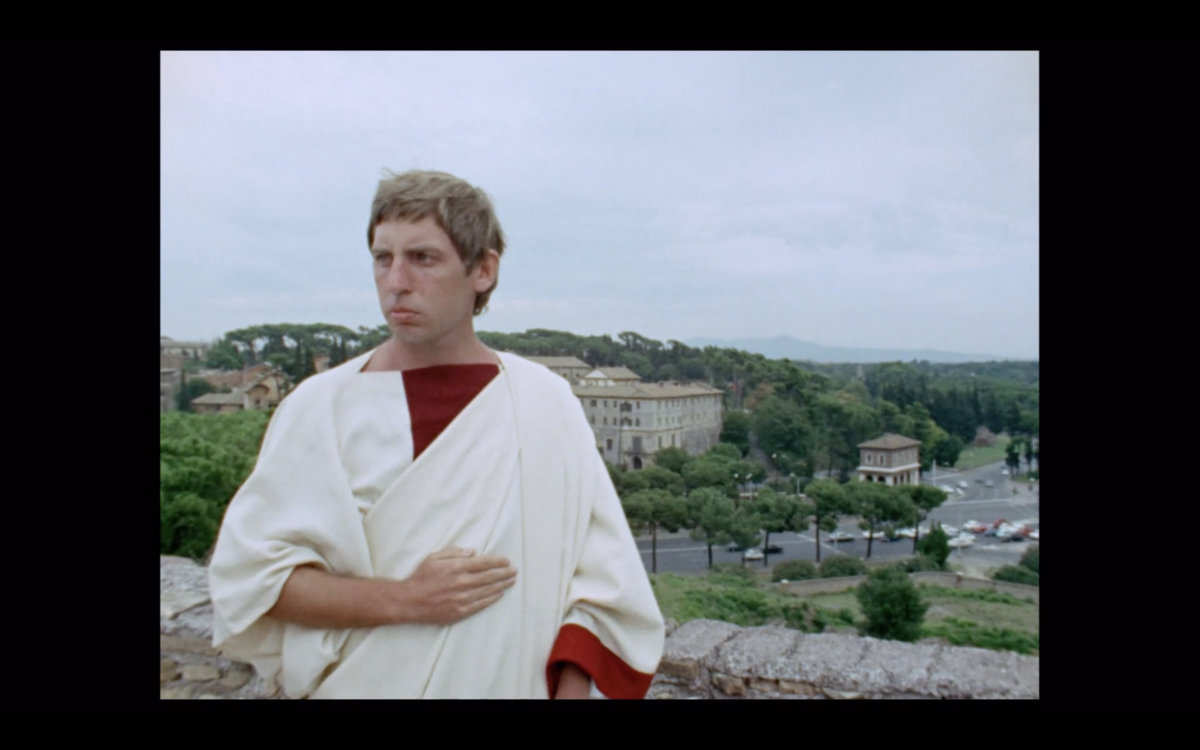
Othon is staged on the top of Rome’s Palatine Hill, where we see the characters wandering around in their togas, in an often controlled theatrical manner, as the bustling 20th century traffic at the foot of the hill crawls forth—still at a seemingly fast pace in comparison to Corneille’s dense language on the foreground, brought without sentiment. In contrast to the contemporary, unpretentious language of the Böll-adaptations, Othon’s complicated and outdated verse, which is not simplified or updated in the performance nor in the accompanying subtitles, remains impenetrable. The fact that the text is declared, cited, contradicts the expectations one would have of a tragedy, its grand displays of emotion. While an antinaturalistic, inflectionless speech is present from the very first of Straub-Huillet’s films, an even greater remove between spoken word and scene surfaces here. In Othon, the text, dense in itself, brought in this literalist manner, becomes a body of matter, a separate entity. Even for a French-speaking audience, it is likely the text remains obscure; most of the actors are not native speakers and unintentionally round out Corneille’s words with thick foreign accents. Those who resort to reading the subtitles, find themselves equally if not more disoriented, as the occasional number of lines is left untranslated. The result of this literalist approach to language is that the text appears as an object in itself to be observed in its materiality. Text becomes more than meaning to be deciphered, instead making manifest the rhythm of speech, age, gender, origin, every particularity of the performing body, which brings its own accent and history.
While the foreign pronunciation of Corneille’s French verse complicates its comprehensibility, the filmmakers have made clear, in their explanation of why subtitles are missing in almost all of their productions, that grasping the text in its entirety is not the purpose of viewing the film. Huillet, who has been responsible for the bigger part of the subtitles (creating the French ones herself and collaborating with translators on both the English and Dutch translations) said that it was a conscious decision to redirect the viewer’s attention from the “conceptual operation” of reading towards “an operation involving only the senses”Cited in B. Turquety. ‘Orality and Objectification: Danièle Huillet and Jean-Marie Straub, Filmmakers and Translators.’ SubStance, vol. 44, no. 2, 2015, pp. 47–65, 53.. Removing the conceptual weight of text, its primarily narrative function, from the forefront, is perhaps Straub and Huillet most obvious shift towards an aesthetics of literalness, one that indeed makes the viewer far more attentive of the materiality of the image.
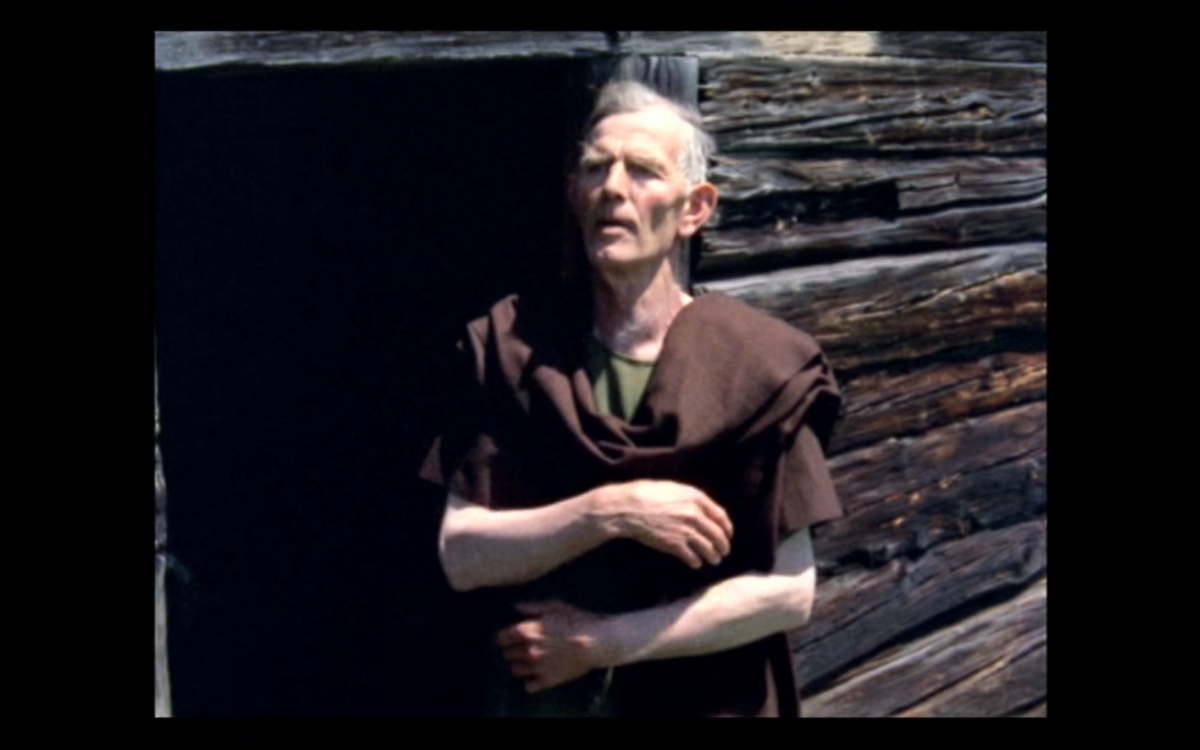
This literalist approach affects not only the text but also the mise-en-scène, as disparate realities are ostentatiously set side by side in a single frame. Given their frequent use of non-actors, for example, we see most of the performers flickering in and out of character: we are simultaneously confronted with their reality, the reality of their body with its history, its gestures, levels of confidence that can be read off of slouching shoulders or proud elongated necks and what they are trying to portray, e.g. the farmer in Geschichtsunterricht (1972) who, towards the end of the interview, adjusts his posture, but does so with the hesitation of someone who, midway, once again becomes aware of the camera. Besides the non-actors’ simultaneous appearance as person and character, a number of anachronisms are consciously emphasized in their films. Take the ancient poet’s colorful 70s beach chair, as well as the car rides and the modern clothing of the interviewer in Geschichtsunterricht; the traffic at the foot of the Palatine Hill visible in Othon.
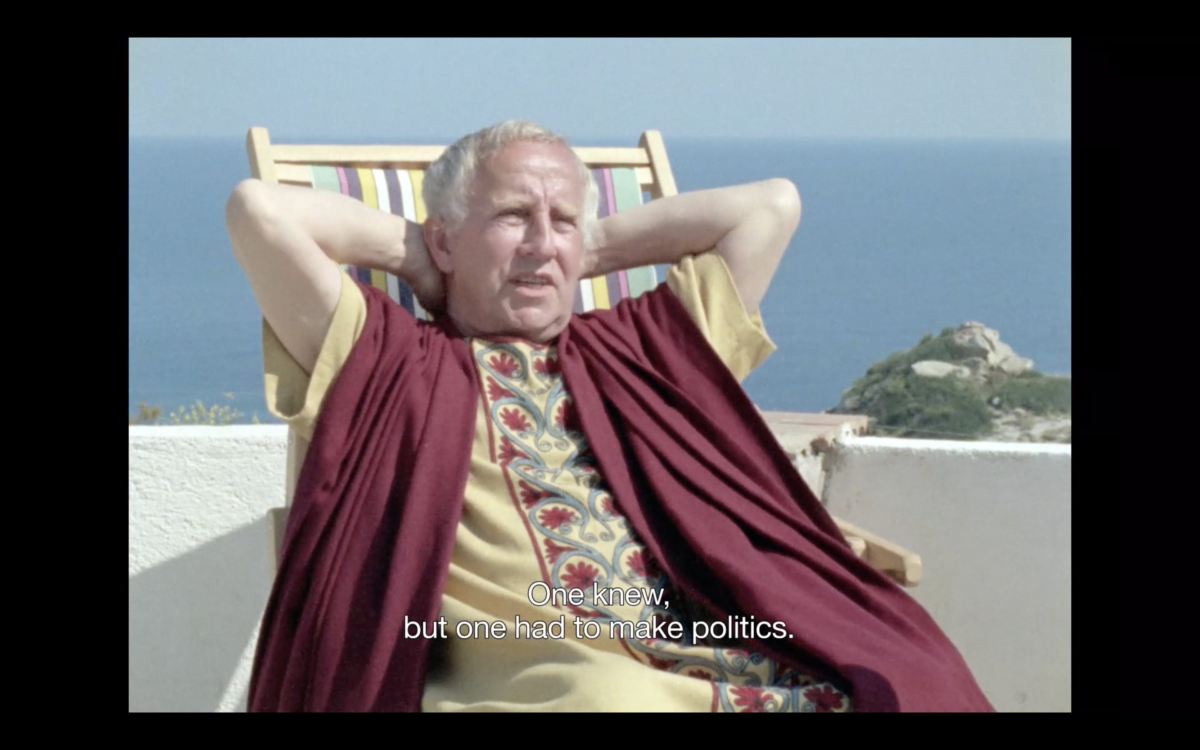
Straub and Huillet choose to adhere to what Bazin particularly praised in Bresson’s adaptation of Bernanos’s Journal d’un curé de campagne:
“Clearly the reality at one stage removed of the novel and that which the camera captures directly, cannot fit or grow together or become one. On the contrary the effect of their juxtaposition is to reaffirm their differences.”Bazin, André. ‘Le Journal d’un curé de campagne and the Stylistics of Robert Bresson‘, 136.
Consequentially, in Straub-Huillet’s work, all that is part of the registered moment is shown, thereby making visible each part of the film’s construction: the actors pronouncing words, not their own, as part of a play, written four centuries ago about events that occurred twenty centuries ago, on a hill in 20th century Rome. It is a making-literal of the historicity of the present: allowing, resituating history in contemporary life, fully conscious of the inability to be truthful, to authentically recreate that history, since it has, as reality, slipped awayThe importance of the text’s ‘slipping out’, its fleetingness and impossibility to be grasped in the oeuvre of Straub and Huillet, has been commented on and linked to Lyotard’s slipping out of reality by Benoît Turquety. in B. Turquety. ‘Orality and Objectification: Danièle Huillet and Jean-Marie Straub, Filmmakers and Translators.’ SubStance, vol. 44, no. 2, 2015, pp. 47–65, 51..
The literalness of Straub-Huillet’s cinema since Othon resembles the literalness of minimalist cinema (Warhol’s Sleep (1964) for example) in as far that both center around the same principle of complete visibility. However, due to the use of textual material in Straub and Huillet, due to the specific approach to language, as well as the unobliterated difference between the reality of the text and that of the recorded present, the literalness goes beyond a registering of a simple act, of a presence, a body in a particular space (the ontological impulse), and is inscribed in a historical perspective (the Marxist impulse). The juxtaposition of the disparate temporalities of the documented text and documented space reaffirms their differences and as such renders the historicity of the present visible. The direct effect of the literalness blocking interpretation beyond an assessment of that which is visible remains, but an alternative interpretation becomes possible given the simultaneous presence of heterogeneous realities within the frame, the various aspects placed together in their pure literalness. The relative obscurity of the narrative, incited by its fast citation and non-native pronunciation of the text and the occasionally withheld subtitles, along with the lack of pathos on the part of the actors, sabotages the readability of the most obvious meaning-giving aspects of the film: conceptual understandability, as well as body language. In the work of Straub-Huillet, literalness (the registration of the body in space, the films made-ness) shifts the possibility of interpretation towards the temporal heterogeneity of the presented realities within the recorded, present reality. Hence, it is no longer the content of the text or metonymic image that incites critical reflection on Europe’s past. Instead, reflection is invoked negatively, through difference: the gap between two blocks of matter, the text and the recording.
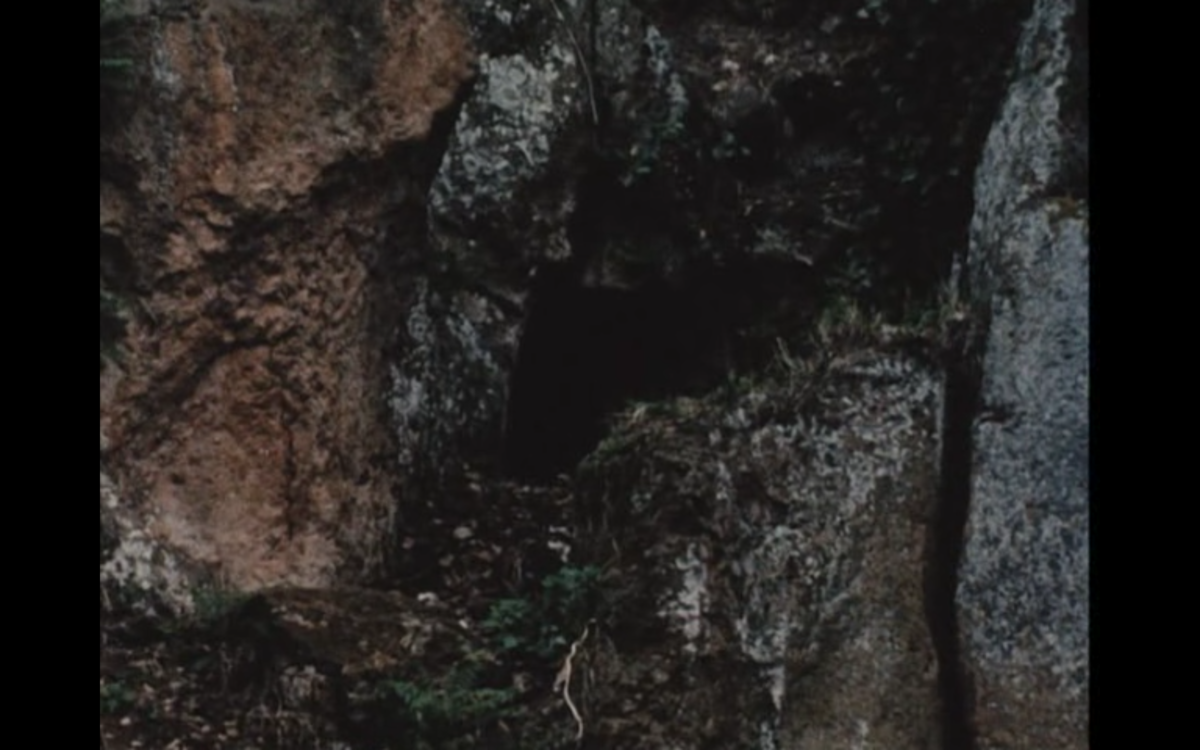
4. Conclusion: From Raw Matter to the Naked Idea
In 1971, Straub commented on the development of their aesthetics as follows:
“I think that more and more the work we’ve got to do—though I have some reservations—is to make films which radically eliminate art, so that there is no equivocation. This may lose us some people, but it is essential to eliminate all the artistic, filmic surface to bring people face to face with the ideas in their naked state.”Cited in Byg, Barton. Landscapes of Resistance: the German Films of Danièle Huillet and Jean-Marie Straub. University of California Press, 1995, 34.
The formalism and hermeticism for which Straub and Huillet are frequently discredited—a reprimand not entirely untenable—is thus linked to their shift toward literalness; a faithfulness to textuality, actors and locations as “raw aesthetic matter” driven by a search for the idea in its naked state. Their literalist aesthetics guides one’s attention not only to the particular materiality of the recording, the sensorial aspects of text, sound and image, but also to a number of central ideas (concerning the role of power, politics, religion…) that recur, in different forms, throughout their oeuvre. In stark contrast to the earliest films, in which the key ideas where metonymically communicated by stand-alone images in the fragmented work in a still rather traditional manner, the later films become far less explicit. Take for example Othon’s opening shot: the camera slowly pans across Roman rooftops towards a small cave at the root of a tree. No explanation is given in the film, but Straub has indicated how the cave served as a weapons cache for resistance fighters during the liberation of Rome. What we are presented with, is a past inscribed in the present, a space fraught with past events, past ideology, that however bears no marks of its historical significance; the past has become invisible and is recorded as such. It is shown without explanation since from the perspective of their literalist aesthetics it would be wrong to narrate this by using, for instance, a voice-over. For Straub and Huillet, this photographic faculty to record, to show the reality—the matter that bears the idea—should always be framed within the theologically underpinned ontological understanding of the medium, a cinematic redemption without a conceptual counterpart.
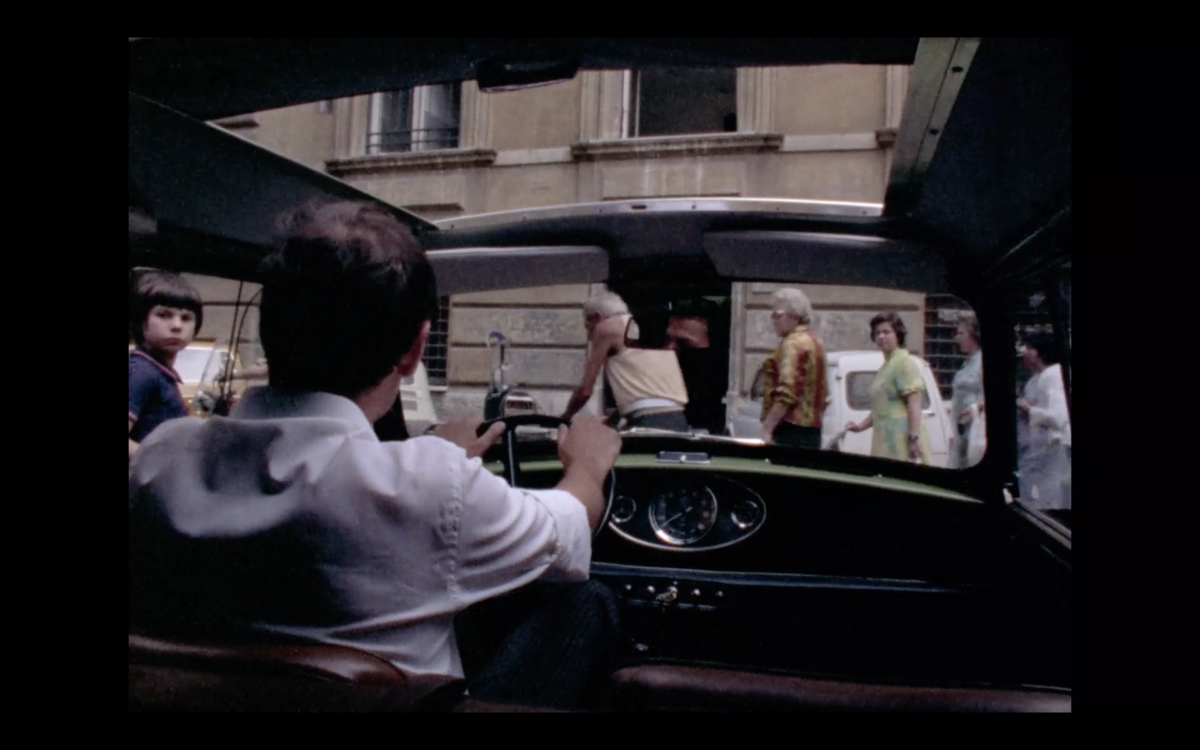
Although complex and implicit, the meticulously structured opening shot remains interpretable: we see Rome, cars in the distance, those particular Italian rooftops and finally the cave, after which the title of the film ‘Eyes Do Not Want to Close at All Times’ appears on screen. The visual logic of Othon’s opening shot perfectly exemplifies Straub and Huillet’s quest for the visible. They rely, firstly, on the ontology of the camera, recording Rome in a documentary manner, an impulse already notable in the intriguing ten-minute car rides through the city in Geschichtsunterricht. Secondly, they rely on a Marxist view of the historicity of the present which leads them to develop an aesthetics based on a difference between text and recorded reality that, with the exception of some rare epiphanic moments, remains irreconcilable.For examples of these epiphanic moments in Straub-Huillet’s work see Wynant, Charlotte and Karel Pletinck ‘What You Gonna Do When the World’s On Fire? Liberté!‘ photogénie, 28 Jan. 2020. The ‘idea’ surfaces as one grasps these differences as what they are, and this through their crude, inartistic disclosure. Straub and Huillet thus rely, thirdly, on a literalist treatment of the material with the aim of reconciling their ontological and Marxist stances towards reality. The political engagement of their aesthetics is constituted of the combination of historical layering, making history visible, and the project to invoke a critical attitude in their audience to make them attentive of the contemporary consequences of the power relations presented.
Retrospectively, Straub and Huillet’s aesthetic shift as it culminates in Othon appears to be strongly rooted in Bazin’s understanding of Bresson’s particularly innovative approach to adaptation. Few filmmakers can be said to have followed through an initial aesthetic program with such meticulousness as well as agility. The hermeticism of the later films can be far more easily interpreted, once seen in the light of the earlier work; as exhibiting more mature expressions of everlasting concerns. As a result, the early films may be considered key works to understand what followed, as their content is still explicit, their method still imperfect. Through this imperfection and the evolution within their oeuvre, one may discern an extremely rigid aesthetic program concerned with both the essence of cinema and crucial 20th century political questions.
